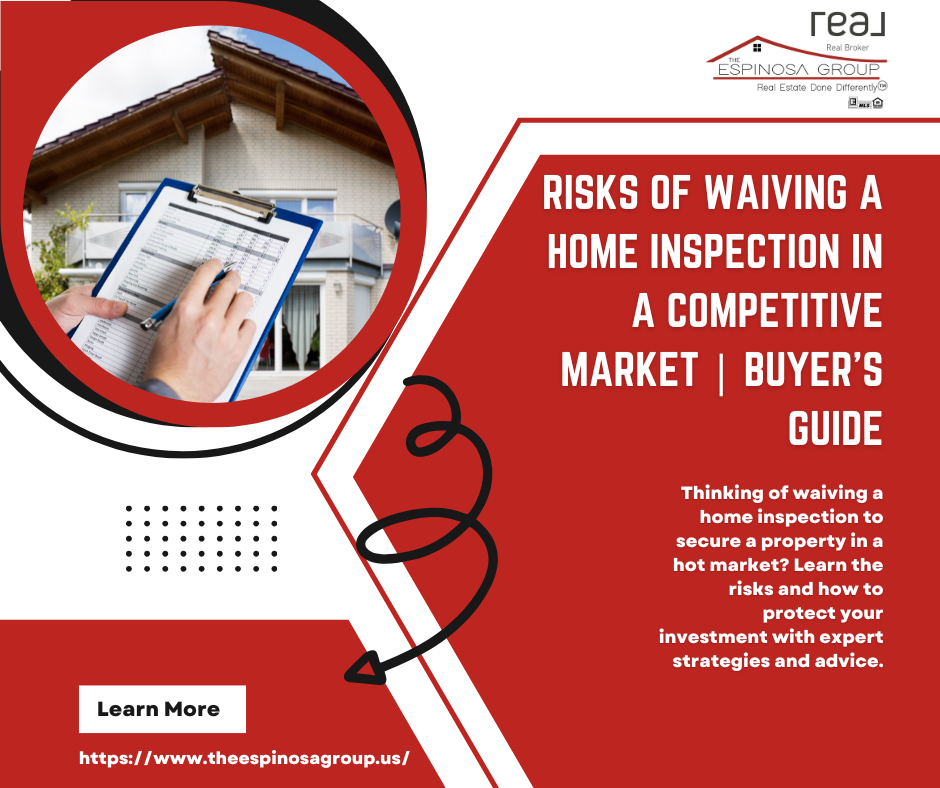Risks of Waiving a Home Inspection in a Competitive Market | Buyer’s Guide
 In a competitive housing market, some buyers may feel pressure to waive the home inspection contingency to make their offer stand out. While this tactic can appeal to sellers and speed up the buying process, it also carries significant risks. Before you decide to skip the inspection, it’s essential to understand the potential pitfalls and how to mitigate these risks to protect your investment.
In a competitive housing market, some buyers may feel pressure to waive the home inspection contingency to make their offer stand out. While this tactic can appeal to sellers and speed up the buying process, it also carries significant risks. Before you decide to skip the inspection, it’s essential to understand the potential pitfalls and how to mitigate these risks to protect your investment.
Why Are Buyers Waiving Inspections?
Home inspections are a standard part of the home-buying process, providing buyers with a professional assessment of the property’s condition. However, in fast-paced markets, buyers may waive this contingency to:
- Strengthen their offer in a bidding war.
- Appeal to sellers looking for a quick, hassle-free transaction.
- Speed up the closing process by eliminating the time needed for an inspection.
While these advantages might seem tempting, waiving an inspection comes with serious risks.
The Risks of Buying Without an Inspection
-
Hidden Repairs and Costs
Without an inspection, buyers may be unaware of costly issues such as faulty wiring, plumbing problems, or foundation cracks. These hidden issues could require significant financial investment after closing. -
Health and Safety Concerns
Undetected problems like mold, asbestos, or poor air quality can pose health risks to you and your family. Structural issues, such as unstable roofs or stairs, could also create safety hazards. -
Lower Resale Value
If the home has underlying problems, it may be harder to sell in the future. Prospective buyers might uncover these issues during their own inspection and demand repairs or lower offers. -
Limited Negotiation Power After Closing
When you waive an inspection, you lose the opportunity to negotiate repairs or a price reduction based on the findings. After closing, the responsibility for addressing any issues falls entirely on you.
How to Mitigate Risks When Waiving an Inspection
If you choose to waive the inspection contingency, there are steps you can take to reduce your exposure to potential problems:
-
Get a Pre-Offer Walkthrough with a Contractor
Bring a licensed contractor or experienced home inspector with you during your pre-offer walkthrough. While this isn’t a full inspection, they can point out obvious red flags, such as water damage, roof issues, or signs of structural problems. -
Request a Seller-Provided Pre-Listing Inspection
Some sellers conduct a home inspection before listing the property and provide the report to buyers. While this doesn’t replace an independent inspection, it can give you a general sense of the home’s condition. -
Focus on Newer or Recently Renovated Homes
While no home is immune to potential problems, newer homes or those with recent updates may pose less risk. Look for documentation of any upgrades, including warranties for appliances or systems. -
Review Seller Disclosures Carefully
Sellers are often required to disclose known issues with the property. Read the disclosure statement thoroughly, and don’t hesitate to ask questions or seek clarification. -
Consider a Post-Closing Inspection
If you waive the inspection contingency but still want to understand the property’s condition, schedule a post-closing inspection. While you’ll be responsible for any issues found, this can help you plan and prioritize necessary repairs. -
Buy a Home Warranty
A home warranty can provide some financial protection by covering repairs or replacements for major systems and appliances within the first year of ownership. -
Be Financially Prepared
Set aside a contingency fund to cover unexpected repairs or issues that may arise after moving in. Having a financial buffer can help you address problems without undue stress.
When Waiving an Inspection May Be Reasonable
While inspections are always recommended, there are scenarios where waiving one may carry less risk, such as:
- New Construction Homes: These are less likely to have major issues, especially if covered by a builder’s warranty.
- Condos or Townhomes: With shared maintenance responsibilities, inspections may be less critical, but they’re still valuable.
- Homes Sold “As-Is”: Sellers in these situations won’t make repairs regardless of the inspection results, so you’ll need to weigh the risks carefully.
Final Thoughts
Skipping a home inspection might give you a competitive edge in a hot market, but it can also leave you vulnerable to significant financial and safety risks. Before making this decision, weigh the pros and cons carefully, and take steps to mitigate potential issues.
Remember, a trusted real estate agent can help guide you through the process and provide expert advice tailored to your situation. At The Espinosa Group, we’re here to help you make informed decisions and protect your investment every step of the way.
Categories
- All Blogs (204)
- Contracts, Negotiations & Process (4)
- Home Buying Process (19)
- Home Buying, Selling, and Investing Tips (57)
- how to buy a house (9)
- How to sell your house (11)
- Importance of a Real Estate Agent (1)
- real estate investment strategies (12)
- Real estate Market in Arizona (6)
- Selling a home (18)
- STAGING DIFFERENTLY (35)
- Staging tips for selling (20)
- THE AGENT (4)
Recent Posts












